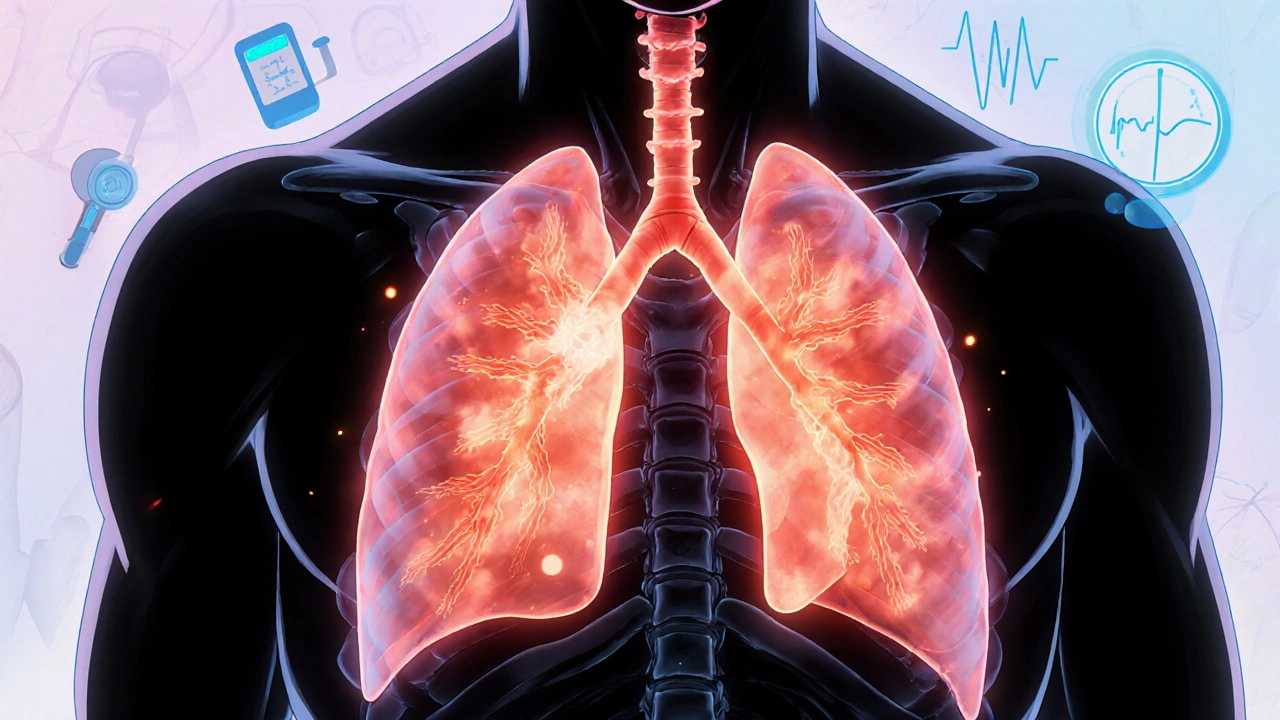Asthma Action Plan Generator
Create Your Personalized Asthma Action Plan
Answer a few questions about your asthma to generate a personalized action plan. This tool is based on guidelines from the Global Initiative for Asthma (GINA).
Key Takeaways
- Asthma is a chronic inflammatory disease of the airways that can be triggered by allergens, infections, exercise, or irritants.
- Typical symptoms include wheezing, shortness of breath, chest tightness, and coughing, especially at night or early morning.
- Diagnosis relies on spirometry, peak flow monitoring, and a careful symptom history.
- Treatment combines relievers (quick‑acting bronchodilators) with controllers (anti‑inflammatory drugs) and lifestyle adjustments.
- Regular review with a healthcare professional helps keep asthma under control and reduces flare‑ups.
Asthma is a chronic inflammatory disease of the airways that makes breathing difficult and unpredictable. It affects millions worldwide, and its severity can change over a person’s lifetime.
What Is Asthma?
Inside the lungs, tiny tubes called bronchi deliver air to the alveoli where oxygen enters the blood. In Asthma, the lining of these bronchi becomes inflamed and overly sensitive. When the body encounters a trigger, the muscles around the airways tighten (bronchoconstriction) and mucus production spikes, narrowing the passage and causing the classic symptoms.
Top Triggers and Underlying Causes
Asthma isn’t caused by a single factor. Most people have a combination of genetic predisposition and environmental exposure. Common triggers include:
- Allergens such as pollen, dust mites, pet dander, and mold spores.
- Respiratory infections (especially viral colds).
- Air pollutants - tobacco smoke, vehicle exhaust, and industrial fumes.
- Exercise, particularly in cold, dry air (exercise‑induced bronchoconstriction).
- Strong emotions or stress, which can tighten airway muscles.
- Occupational exposures - chemicals, dust, or fumes in certain jobs.
Family history matters; having a parent or sibling with asthma raises your risk by up to 30%.
How to Spot the Symptoms
Recognising early warning signs prevents severe attacks. Look for:
- Wheezing - a high‑pitched whistling sound when breathing out.
- Shortness of breath, especially during physical activity.
- Chest tightness or a feeling of heaviness.
- Persistent cough, often worse at night or early morning.
- Increased mucus production or the need to clear the throat.
Symptoms that improve with a quick‑relief inhaler are highly suggestive of asthma.

When to See a Doctor
If you notice any of the following, schedule an appointment:
- Symptoms that interfere with daily activities or sleep.
- Frequent use of over‑the‑counter cough medicines without relief.
- Repeated nighttime awakenings due to coughing or wheezing.
- History of severe infections that seemed to worsen breathing.
- Any concern that symptoms could be confused with other conditions such as COPD or heart disease.
Testing and Diagnosis
The gold‑standard test is spirometry, which measures how much air you can exhale and how fast. A drop in forced expiratory volume (FEV1) after inhaling a bronchodilator confirms reversible airway obstruction - a hallmark of asthma.
Another useful tool is the Peak Flow Meter. It provides an at‑home snapshot of airway caliber and helps track daily variations.
Doctors may also order allergy testing, chest X‑rays, or fractional exhaled nitric oxide (FeNO) assessments to pinpoint inflammation.
Treatment Options Overview
Effective asthma management blends medication with lifestyle tweaks. The goal is to keep symptoms minimal and prevent flare‑ups.
The two main medication categories are:
- Relievers - short‑acting drugs that quickly open the airways during an attack.
- Controllers - long‑term medicines that reduce inflammation and airway hyper‑responsiveness.
Below is a quick glance at the most common options.
| Medication Type | Mechanism | Typical Use | Advantages | Disadvantages |
|---|---|---|---|---|
| Short‑acting Beta Agonist (SABA) | Stimulates β2‑receptors → rapid bronchodilation | Rescue inhaler for sudden symptoms | Fast relief within minutes | Does not treat inflammation; overuse can worsen control |
| Inhaled Corticosteroid (ICS) | Reduces airway inflammation at the cellular level | Daily controller for persistent asthma | Proven to lower exacerbations | May cause oral thrush; requires regular use |
| Long‑acting Beta Agonist (LABA) + ICS combo | Bronchodilation + anti‑inflammatory | Maintenance therapy for moderate‑to‑severe asthma | Convenient single inhaler | LABA must never be used alone; risk of side‑effects if misused |
| Leukotriene Modifiers | Block leukotriene receptors → reduce inflammation and mucus | Oral alternative for mild‑moderate asthma | Useful for patients who struggle with inhaler technique | Less effective than high‑dose ICS; may cause mood changes |
| Biologic Therapy (e.g., Omalizumab) | Targets IgE or specific cytokines to curb severe inflammation | Severe allergic asthma uncontrolled by standard meds | Significant reduction in hospitalizations | Injectable; high cost; requires specialist monitoring |

Medication Classes Explained
Below each class gets a deeper look, complete with real‑world tips.
Short‑acting Beta Agonist (SABA)
SABAs, like albuterol, act within minutes to relax airway muscles. Keep a rescue inhaler at hand during workouts, travel, or when you know a trigger is nearby. A common mistake is using a SABA as a daily controller - it won’t lower inflammation, and frequent use often signals poor overall control.
Inhaled Corticosteroids (ICS)
ICS are the backbone of long‑term asthma care. They come in low‑dose (for mild disease) and high‑dose (for moderate‑to‑severe). To avoid oral thrush, rinse your mouth after each inhalation. Many patients feel better within a week, but full anti‑inflammatory benefits may take a month.
Long‑acting Beta Agonist (LABA) + Inhaled Corticosteroid Combination
Combining a LABA with an ICS in one inhaler simplifies regimens. Tools like dose‑counter inhalers help you track usage. Remember: LABA never works alone; the anti‑inflammatory action of the steroid is essential for safety.
Leukotriene Modifiers
Oral tablets such as montelukast block leukotrienes, chemicals that tighten airways during allergic reactions. They’re handy for kids who dislike inhalers. Watch for mood swings or sleep disturbances; if they appear, discuss alternatives with your doctor.
Biologic Therapy
Biologics are injectable antibodies that neutralize specific immune pathways. Omalizumab, for instance, binds IgE, reducing allergic inflammation. They’re prescribed after poor response to high‑dose ICS/LABA. Injections are usually every 2-4 weeks and require monitoring for rare allergic reactions.
Non‑Drug Management Strategies
Medication alone isn’t enough for most people. Lifestyle tweaks can cut flare‑ups dramatically.
- Trigger avoidance: Use allergen‑proof bedding, keep windows closed during high pollen days, and install HEPA filters.
- Regular exercise: Gradual warm‑ups and using a short‑acting inhaler 15 minutes before activity can prevent exercise‑induced symptoms.
- Weight management: Excess weight adds pressure on the diaphragm, worsening breathlessness.
- Vaccinations: Flu and COVID‑19 shots reduce the risk of infection‑related exacerbations.
- Breathing techniques: The “pursed‑lip” and “diaphragmatic” methods help keep airways open during an attack.
Living with Asthma: Daily Tips
- Carry your rescue inhaler at all times - the best time to use it is the moment you feel tightness, not after the attack worsens.
- Track symptoms with a Peak Flow Meter. Record morning and evening readings; a sudden drop signals a need to adjust medication.
- Review your asthma action plan with your doctor at least twice a year. The plan should list green (stable), yellow (caution), and red (emergency) zones based on symptom severity and peak flow values.
- Keep your inhaler devices clean; residue can block the spray nozzle. Follow manufacturer instructions for disassembly and washing.
- Educate family, friends, and coworkers about your condition. They should know how to help if you experience a severe attack.
Frequently Asked Questions
Can adults outgrow asthma?
Some adults experience fewer symptoms as they age, especially if they avoid triggers and stick to their medication plan. However, asthma rarely disappears completely; most people retain some level of airway hyper‑responsiveness.
Is it safe to use a rescue inhaler while pregnant?
Yes. Short‑acting beta agonists like albuterol are classified as Category B, meaning they’re considered safe for use during pregnancy when needed. Always discuss dosing with your obstetrician.
What is the difference between a SABA and a LABA?
A SABA (short‑acting) works within minutes and lasts 4‑6 hours, making it ideal for sudden attacks. A LABA (long‑acting) takes longer to kick in but provides relief for up to 12‑24 hours, so it’s used daily as a controller, never alone.
How often should I replace my inhaler?
Most metered‑dose inhalers have a built-in dose counter. Replace the inhaler when the counter hits zero or if you notice a change in spray quality, even if the counter still shows doses left.
Are there natural remedies that work for asthma?
Some people find relief with breathing exercises, omega‑3 fatty acids, or vitamin D supplementation, but none replace prescribed medication. Always talk to a doctor before adding supplements.
When is it necessary to see a specialist?
If you need high‑dose inhaled steroids, frequent oral steroids, or biologic therapy, a pulmonologist or allergy specialist should manage your care. Also, uncontrolled symptoms despite optimal inhaler technique warrant specialist input.
asthma treatment isn’t one‑size‑fits‑all, but by understanding triggers, mastering inhaler technique, and partnering with a healthcare professional, most people keep their disease under control and enjoy a normal, active life.

Ben Bathgate
October 19, 2025 AT 14:18Great summary, but you left out the cost issue of biologics.
Christian Georg
October 20, 2025 AT 18:05Thanks for the thorough rundown! I appreciate the clear breakdown of triggers and the step‑by‑step action plan. For anyone just starting out, tracking peak flow twice daily can reveal patterns you didn’t notice before. Don’t forget to rinse your mouth after each inhaled steroid dose to avoid thrush 😊. Also, consider a HEPA filter if you’re allergic to dust mites – it’s cheap and makes a noticeable difference. Keep sharing updates, the community learns from real‑world tweaks.
Christopher Burczyk
October 21, 2025 AT 21:52The article provides a solid overview, yet it could benefit from a deeper discussion of the pharmacokinetics of inhaled corticosteroids. Understanding particle size distribution is essential for optimizing deposition in the lower airways. Moreover, the distinction between dose‑dependent and dose‑independent side effects warrants explicit mention. Clinical guidelines also emphasize the stepwise approach, which should be highlighted more prominently. Overall, the content is accurate but could be expanded for an expert audience.
Nicole Boyle
October 23, 2025 AT 01:38Nice compendium, especially the way you enumerate the immunopathogenic cascades. The terminology around eosinophilic versus neutrophilic phenotypes adds valuable granularity. I’d suggest inserting a brief note on airway hyper‑responsiveness metrics such as PC20. Also, the table could flag which agents are off‑label for pediatric use. Otherwise, solid groundwork for both clinicians and patients.
Maridel Frey
October 24, 2025 AT 05:25Thank you for the inclusive layout; the stepwise action plan is especially helpful for newcomers. It might be useful to add a reminder about the importance of regular follow‑up appointments to reassess control levels. Additionally, a quick tip on how to clean inhaler devices could prevent dosing errors. Your thoroughness makes the information accessible to a broad audience.
Jay Kay
October 25, 2025 AT 09:12Honestly this guide is spot on, but don’t forget that ignoring the cost of biologics can ruin a patient’s budget.
Jameson The Owl
October 26, 2025 AT 11:58Asthma is a chronic inflammatory airway disease that affects millions worldwide. The immune system in asthmatics reacts hyperactively to environmental antigens. Genetic predisposition sets the stage for exaggerated responses. Triggers such as pollen dust mites and mold spores initiate bronchoconstriction. Viral respiratory infections can amplify airway hyper‑responsiveness. Exercise in cold dry air adds a mechanical stress that narrows bronchioles. Stress hormones also modulate smooth muscle tone in the airway wall. Occupational exposure to chemicals dust fumes further aggravates inflammation. The pathophysiology involves eosinophil infiltration and cytokine release. Airway remodeling progresses with repeated insults leading to fixed obstruction. Spirometry remains the gold standard for diagnosis and monitoring. Peak flow monitoring offers a convenient home‑based assessment. Inhaled corticosteroids reduce cytokine mediated inflammation by downregulating gene expression. Short‑acting beta agonists provide rapid bronchodilation by stimulating beta‑2 receptors. Biologic therapies target specific immune pathways such as IgE or interleukin‑5. Proper adherence to medication regimens prevents exacerbations and hospitalizations.
Rakhi Kasana
October 27, 2025 AT 15:45While the overview is exhaustive, it glosses over the real‑world challenges of insurance approval for advanced therapies. Patients often face delays that can exacerbate symptoms. Highlighting advocacy resources would empower readers.
Sarah Unrath
October 28, 2025 AT 19:32i think you should also mention how important the inhaler technique is lol
James Dean
October 29, 2025 AT 23:18Asthma is a complex beast its triggers are everywhere you look it’s not just pollen. Managing it means listening to your body and adjusting meds when needed. Keep your inhaler handy at all times.
Sunil Yathakula
October 31, 2025 AT 03:05Hey, great job breaking it down! I totally get how scary an attack can feel, especially when you’re in the middle of a workout. Remember to warm up slowly and keep that rescue inhaler in your pocket. Also, staying hydrated helps keep mucus thin. You’ve got this – keep tracking those peak flow numbers!
Ankitpgujjar Poswal
November 1, 2025 AT 06:52Fantastic guide! Make sure to stick to your controller meds daily – no excuses! If you feel a flare‑up coming, act fast and use your rescue inhaler. Consistency is the key to keeping asthma in check.
Bobby Marie
November 2, 2025 AT 10:38Nice article. Could you add a quick tip on cleaning inhalers?
Caroline Keller
November 3, 2025 AT 14:25This piece is a lifesaver for anyone battling breathlessness. It’s heartbreaking how many people suffer in silence because they don’t know these tricks. The detailed action plan feels like a beacon of hope in a storm. I’m grateful for the empathy woven throughout. Keep spreading this vital info!
dennis turcios
November 4, 2025 AT 18:12Overall solid article, but it could use a bit more depth on the side‑effects of long‑term steroid use. Also, a note on the environmental impact of disposable inhalers would be relevant. The table is helpful, though a few more columns on cost could improve it. Still, good work assembling a comprehensive guide for laypeople.